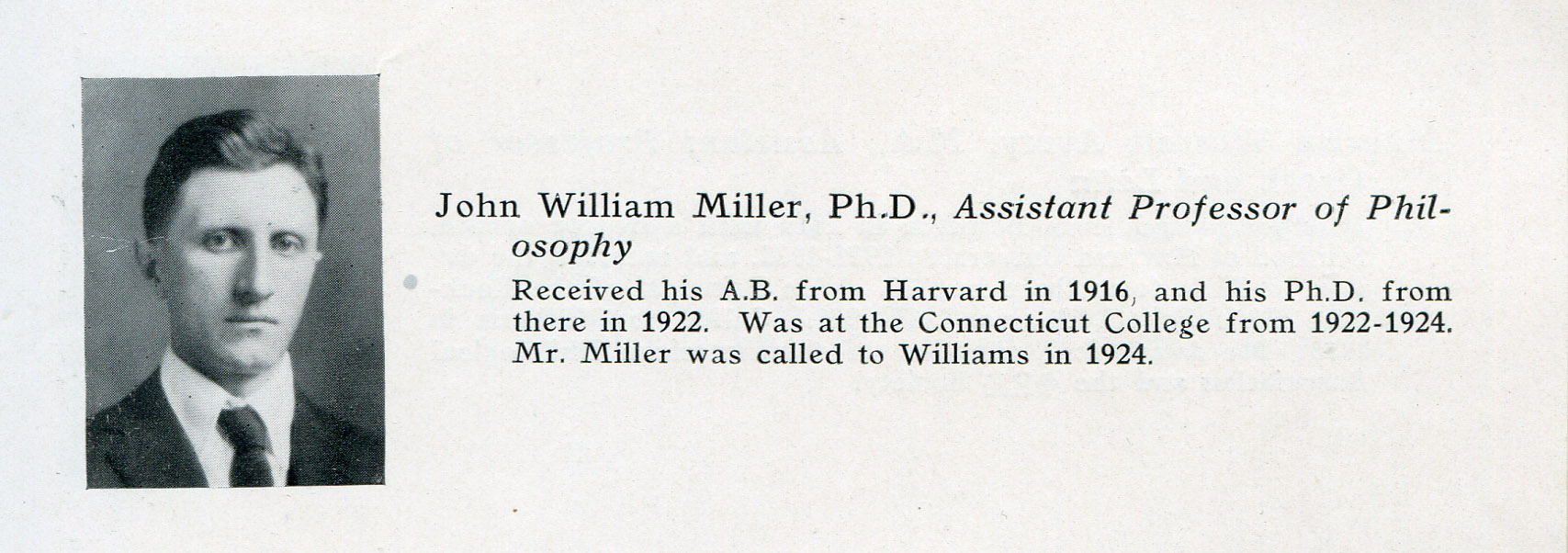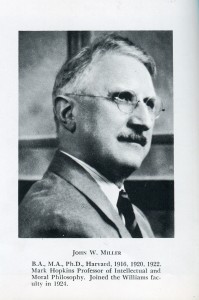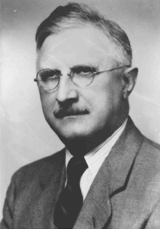Miller’s was a quiet and relatively uneventful life amidst a time of great change. His 83 years, ranging from the 1890s to the late 1970s, saw two world wars as well as such great social upheavals as the Depression, the fall of Jim Crow, and the rise of radical youth culture in the 1960s. On the philosophic front, within the scope of his lifetime the great debate at Harvard between idealism and pragmatism reached its crescendo and quickly went silent, critical realism came in vogue, various forms of positivism were imported from Europe, existentialism had its day, and, near the end of his life, phenomenology began to take its place in the American scene. In the classrooms of Williams College as well as in the parlor of his home, Miller was an engaged participant in these events. For the outward calm of his days belied his thoughtful concern with and personal development amidst these larger trends.
A Sketch of Miller’s Life
John William Miller (1895-1978) was born on January 8th in the city of Rochester, New York, to John and Minnie (née Richter) Miller. His father was involved in the coal and lumber businesses, and he fashioned a modest but not always secure livelihood in these areas. Along with his three sisters and one brother, John William Miller was raised in the Roman Catholic faith and educated in the public schools of his native city. It was at Harvard that Miller began his undergraduate studies in 1912, although for family financial reasons he transferred to the University of Rochester for his sophomore and junior years. He returned to Cambridge, Massachusetts, for his senior year and received his A. B. at Harvard in 1916. For a year after his graduation Miller worked for the North East Electric Company in Rochester. At the onset of American involvement in the First World War Miller declared himself a conscientious objector and subsequently volunteered for service in the ambulance corps. In France he saw active duty with Base Hospital 44.
Graduate Education. Upon his return from the war, Miller worked briefly in the production department of the Kellog Manufacturing Company. In 1919, motivated in part by his war experience, Miller returned to Harvard to begin graduate studies in philosophy. Among his teachers were Ralph Barton Perry and Edwin Bissell Holt, both of the realist persuasion, and William Ernest Hocking and Clarence Irving Lewis on the more idealistic side. The realist-idealist debate at Cambridge was lively. There was another debate, however, that was equally influential—i.e., the “battle of the Absolute” that had been waged between Josiah Royce and William James. (Miller had studied under Royce as an undergraduate.) Indeed, Miller’s philosophy—which he termed a “historical idealism” and a “naturalistic idealism”—was formed in the crucible of the disagreement between Royce’s idealism and James’s pragmatism. While Miller’s intellectual environment at Harvard was rich, it is still fair to say that that his strongest philosophical influences dated from the 19th century and were, most prominently, the German idealists Immanuel Kant, Johann Gottlieb Fichte, and Georg Wilhelm Friedrich Hegel.In 1921 Miller received his master’s degree and, under the direction of Hocking, went on to compose a work on the fundamental connection amongst epistemology, semiotics, and ontology. This work, titled “The Definition of the Thing,” earned him the doctorate in 1922.
Williams College. Miller’s teaching career began in 1922 with an appointment at Connecticut College. (During this time he married Katherine S. Gisel [1897-1993].) In the autumn of 1924 he took a position at Williams College where, apart from two summer sessions and a one-year visiting appointment, he spent the balance of his teaching career.

It was in Williamstown, first in a home on South Street and then in the large house on Grace Court (now Morley Drive), that he and Katherine raised their two sons, Eugene (born 1925) and Paul (born 1928). Both men went on to study philosophy in college whereafter Eugene became a newspaper reporter (and later editor and publisher) for the Sentinel of Ansonia, Connecticut, and Paul took a position as a professor of philosophy at the University of Colorado and, later, at the University of Southern California.The summer teaching appointments mentioned above were at Rochester University and Boston University. The visiting appointment was at the University of Minnesota, and lasted for the full academic year of 1937-1938. The year in Minnesota—where Miller befriended Professor Alburey Castell with whom he would have a long philosophical correspondence—was precipitated by a widespread feud within Williams College that pitted Miller and others against the then-president of the college, Tyler Dennett.
Aside from these interludes, Miller was a presence at Williams from 1924 through 1960, serving as chair of the philosophy department from 1931 to 1955 and influencing three generations of students. From 1945 on he was Mark Hopkins Professor of Intellectual and Moral Philosophy, an august title inherited from his colleague and predecessor as chair the critical realist James Bissett Pratt. In addition to that formal, college honor, Miller was regularly selected by graduating classes as the most influential professor at Williams and twice the college yearbook was dedicated to him.
It was as a teacher and not as a scholar that Miller intially was best known. Indeed his reputation as a thinker spread via his teaching practice and the modest fame that came to him by means of the accounts of his former students. At Williams, Miller taught courses across the whole philosophical curriculum—i.e., epistemology, metaphysics, aesthetics, semiotics, and political philosophy. Perhaps his greatest innovation in the classroom, aside from his formidable and engaging personal presence, was the introduction of a course in the philosophy of history at a time when positivism was further separating philosophical analysis from historical thinking.
Writing & Retirement. Upon his retirement in 1960, Miller remained in Williamstown. In the parlor of the large house on Grace Court—directly behind the science quadrangle and within short walking distance of the main commercial thoroughfare of Spring Street—he received guests for philosophical discussion for the next 28 years.During the period of his retirement, Miller continued to write extensively on philosophical subjects. As was the case when he was actively teaching, he maintained an uneasy relationship with the professional academic establishment and its standards for philosophical discourse. Over the course of his 36 years at Williams College, Miller made only six major public presentations of his philosophical views. Two came in the form of essays published in The Journal of Philosophy : “The Paradox of Cause” (1935) and “Accidents Will Happen” (1937). The other four were public papers: “Freedom as a Characteristic of Man in a Democratic Society” (American Political Science Association, Chicago, 1938), “History and Humanism” (Harvard Philosophy Club, 1948), “The Midworld” (Harvard Philosophy Club, 1952), and “The Scholar as Man of the World” (Phi Beta Kappa Society, Hobart College, 1952).

The years of his retirement found Miller faced with the strong encouragement of a handful of former students who urged him to publish these four public addresses and some of the many essays that he had penned over the years. George P. Brockway and Edward A. Hoyt (both Williams College ’36) were particularly influential in this effort. In 1944, early in his career as an editor at W. W. Norton, Brockway had contracted Miller to publish his dissertation, “The Definition of the Thing.” (The contract was not put into effect until after Miller’s death.) For his part, after the war Hoyt began collecting and transcribing Miller’s essays with an eye toward publication. (Many of these essays eventually appeared in The Paradox of Cause.) Later, in 1961, Brockway would facilitate the publication of “The Ahistoric and the Historic” as an Afterword to a volume of translated essays by José Ortega y Gasset. Finally, by the late 1970s, Brockway inveighed upon Miller to form a collection of his essays which was published, in 1978, under the title The Paradox of Cause and Other Essays.
While retirement did eventuate in this major publication, Miller passed his latter years quietly, conducting philosophy in the form of conversation and correspondence much as he had during his teaching career. Philosophy was for him, finally, a personal matter, something that passed between individuals and apropos of particular events or concerns. His rapprochement with publishing in the 1970s could not be said to have fundamentally changed his opinion on this matter.
Miller died, at the North Adams Regional Hospital, on December 25, 1978, and was buried in the Westlawn Cemetery just west of the Williams College campus. Miller was survived by his wife Katherine and his two sons Eugene and Paul. Upon Katherine’s death in 1993, the family home became property of the college and is now called Miller House.

